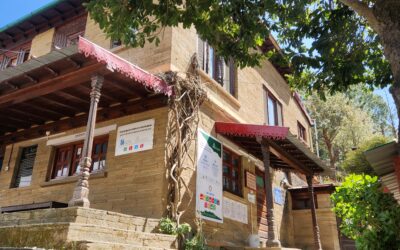The Unfinished Childhood
Koliwas, a small hamlet in Rapar taluka of Kutch, is home to just forty households. Located ten kilometers from the main village of Desalpar, it is a place where time seems to stand still. The landscape is dotted with traditional bhungas and semi-pakka houses, but there are no schools, hospitals, or basic facilities. Life here is simple, yet harsh.
In this remote village, I met Parvatiben. At first glance, she appeared to be just an 18-year-old girl—frail, with a pale face that bore the marks of hardship far beyond her years. As we spoke, I learned that she had given birth to her second child merely a month ago. The realization that someone younger than me had already become a mother of two was unsettling.
Parvatiben’s story began long before she even understood its implications. She was engaged before she turned seven, a fact she remained unaware of at the time. At the age of 15, she was married and, soon after, found herself pregnant. What should have been a phase of youthful dreams and aspirations was instead replaced by the struggles of impending motherhood.
Pregnancy brought with it immense challenges. Her young body, still developing, underwent drastic changes. She felt different, vulnerable, and unprepared, but support was scarce; and continued to carry out household chores without rest. She didn’t even complete all four antenatal check-ups. By the third trimester, she was severely anemic, but no one noticed—there were no doctor visits, no proper nutrition, no supplements.
When she went into labor, it became a battle between life and death. With no proper medical attention, both she and her child were at risk. Against all odds, she delivered a baby boy, but he was dangerously underweight. After childbirth, she was advised to use a Copper-T to delay another pregnancy, but her in-laws refused. To them, it was an unnatural interference. Parvatiben had no say over her own body, her own future.
A year later, history repeated itself. She was pregnant again. This time, however, thanks to the intervention of Gram Swaraj Sangh (GSS), she received some medical support. Yet, the journey was still perilous. The second delivery was equally critical, and once again, the baby was underweight.
Now, before even turning 18, Parvatiben is a mother of two children, both under the age of two. Her story is not just her own—it is a reflection of countless young girls whose childhoods are cut short, their futures dictated by age-old traditions. As I listened to her, I couldn’t help but wonder: where was I when I was 15? Sitting in a classroom, chasing constantly evolving dreams …
The Silenced Love Of Youth
The air in Bilaspur panchayat hung heavy with unspoken expectations. Priya and Karan, two souls entwined by a love as bright as the midday sun, found their haven in the shared pages of their schoolbooks. They were the same caste, a detail that should have smoothed their path, yet their hearts yearned for a life unbound by tradition. Their love was a secret flame in a world where whispers carried more weight than declarations. But their love story was destined to be more than a fleeting romance. They dared to dream, to imagine a future painted in hues of their own choosing. Their rebellion was an elopement, a desperate leap into the unknown.
The search for the young couple began, frantic and desperate. The parents searched, their anger stoked by a sense of betrayal. They were found. The police station became the stage for their capture, a cold and sterile space where their love story was deemed an offense. Priya, with the fire of defiance burning in her eyes, played her last card. A fake trip to the washroom. A dash into the surrounding forest, hiding beneath a bridge, as the constables and her family searched for her.
The forest was her refuge, the silence her only companion. But hunger pangs were the final blow to her freedom. She returned to the police station. The food offered to her tasted like ashes in her mouth. Their parents’ wrath fell upon them, the blows a brutal punctuation to their love story. They were beaten, their spirits wounded. But the story did not end there. Three months later, Priya’s fate was sealed. She was married off to someone else, a stranger, her dreams crushed under the weight of tradition. A life that once held the promise of love was traded for one of submission.
I had once believed that sharing the same caste was sufficient for a marriage to be permissible. However, I have come to realize that a love marriage is not always sanctioned, even when both individuals belong to the same caste. The reasoning offered in such cases is that, despite belonging to the same caste, it is inconceivable that one could fall in love and contemplate marriage with their partner. Marital union will only be allowed on the conditions set forth by the elders of the family.
The tale of Priya and Karan serves as a grim reminder of the dark reality of child marriage. It is a tragedy played out in countless villages, where love is sacrificed at the altar of societal norms. It is a loss not just for the individuals, but a tragedy for the entire community, for it perpetuates a cycle of sorrow and inequality.
The Aata-Saata System Of Kinship
Bhilwara, a small town in the south-central region of Rajasthan, is well known for its industries. The local dwellers in this region are often found to be engaged in either such industrial services or with a business service of their own. The place that I reside in, is a residential sort of a place with houses built in rows. I avail the tiffin services that provide me with daily dinner and weekend lunches.
This is run by Jyoti Aunty, providing almost 10 houses everyday, working all day preparing for the freshly made meals. One day, upon making conversations with her, I got to know that she was only 14 when she was married. Shocked, I asked her, “how come so early?”, to which she casually replied,
“I had no idea I was getting married, whatever parents instructed, I got it done. The marriage was done along with her brother’s marriage at the age of 22, reducing the cost and burden on the family by completing two marriages at once.”
Another complementing story is of the beauty parlour aunty, who in her house runs a small boutique, to whom I also visit for my occasional face threading. One such day, while I visited her boutique, I asked how long she’s been in this town. She replied “ever since I was married, after being engaged at the age of 10”. Upon asking how come at the age of 10, to which she shrugged off saying “so what, this is what the culture here is. I got married off along with my sister, who was 18 at the time, along with another sister who was 14, and then me, 10”.
This marriage custom is known as ‘aata-saata’, wherein, women of the same family marry men of the other family, often brothers, at the same time for two main reasons. One is to form a familial bond with only one another’s kin, by arranging the marriage of all the girls in the same family, strengthening the ties, structurally. Functionally, to also reduce the extra costs it would have incurred if the marriages were conducted separately.
The name itself denotes symbolic gesture, ‘aata’ meaning flour, signifying women in the cooking space and ‘saata’ meaning payments or other tokens, signifying the value rate for which the girl is getting married.
The traditional aspects meet the financial burdens of families with girl children, leading to exchanges of under age marriages of girl children of the family. Now, after early marriages due to financial distress, it is these women who have a certain income flowing into the household. The reason they were married off at a young age, now contributes to the family with their own independent earnings.
A Decade Without Records Of What Is Crime
In the last five months during my field visits, I have met many Balika Badhus (child bride) in Kutch district. In most patriarchal society in India, people think that girls are the honor (not the pride) of the family. Therefore, to save the honor of their family, they think the girls should be married as soon as possible and sent to their father-in-law’s house. Kutch is no different. A wide variety of castes can be found in the district, with most caste societies marrying off their daughters at a very young age.
At work, as part of data analysis, I got 10 years (2013-2024) of crime data from the DSP office of east Kutch region, which does not have a single case register of child marriage.
Can it be considered or believed that in that long period of time not a single case of child marriage has been registered where I am constantly encountering them? Who is at fault here? So many social organisations have been working here for so many years, even after that a single case wasn’t registered?
So, aren’t they continuing their work by accepting these practices of society to just maintain good relations with the people, police and government? Are they trying to remove this evil practice of the society or not? If they are really trying to finish it, then why is the information not showing up at all? If someone outside this state researches with these information, it will come out as child marriage is almost non-existent here. Would this kind of research be informative? Would it be correct?
After much thought I spoke to my organization why is child marriage not registered with the police? This time I found out that just a few years ago, Kutch Mahila Vikas Sangathan (KMVS) filed a court case to stop 11 child marriage at once. They were from the Rabari community of Anjar and Bhuj taluka. After a whole day of communication and joint efforts of DSPO (District child protection officer) and KMVS, the marriages were stopped.
Again 4th Feb of 2025 KMVS got to know about a large number of child marriage is going to happen. Immediately KMVS contacted the DSPO and successfully stopped those marriages. But still there is no registration of these cases in police stations.
I discussed it in my organization but haven’t got a satisfactory answer. So, I went to the District Child Protection Office and met with Kutch DSP Officer Bipul Bhai. He told me that whenever they get to know about a child marriage, it is directly been registered to the court. So, police don’t have to always be involved. Maybe that is why there is no case registered with police. I am still not satisfied with all these answers and am in search of the complete trail, and truth.
Conclusion: A Reality That Demands Reflection
The stories of Parvatiben, Priya, and Jyoti Aunty are not just stories of them, but rather stories of many women in this society. Reflections on this deep-rooted issue persisting over the years becomes necessary. The patterns although outwardly looks like a changed system, still has repeated patterns of child marriage, loss of bodily autonomy being perpetuated. Rather, there has been invisibility that starts showing in the official records, as seen in the Kutch case.
The understanding of how child marriage in different regions of India, morphed and mixed into the local micro-culture needs to be there. If there are laws to prevent it, why do they fail to reach villages like Koliwas and Bilaspur? If organizations intervene, why are there no police records? What kind of future are we shaping where a girl has no choice over her own life? These are not easy questions, nor do they have simple answers. But perhaps, recognizing them is the first step toward change.




0 Comments